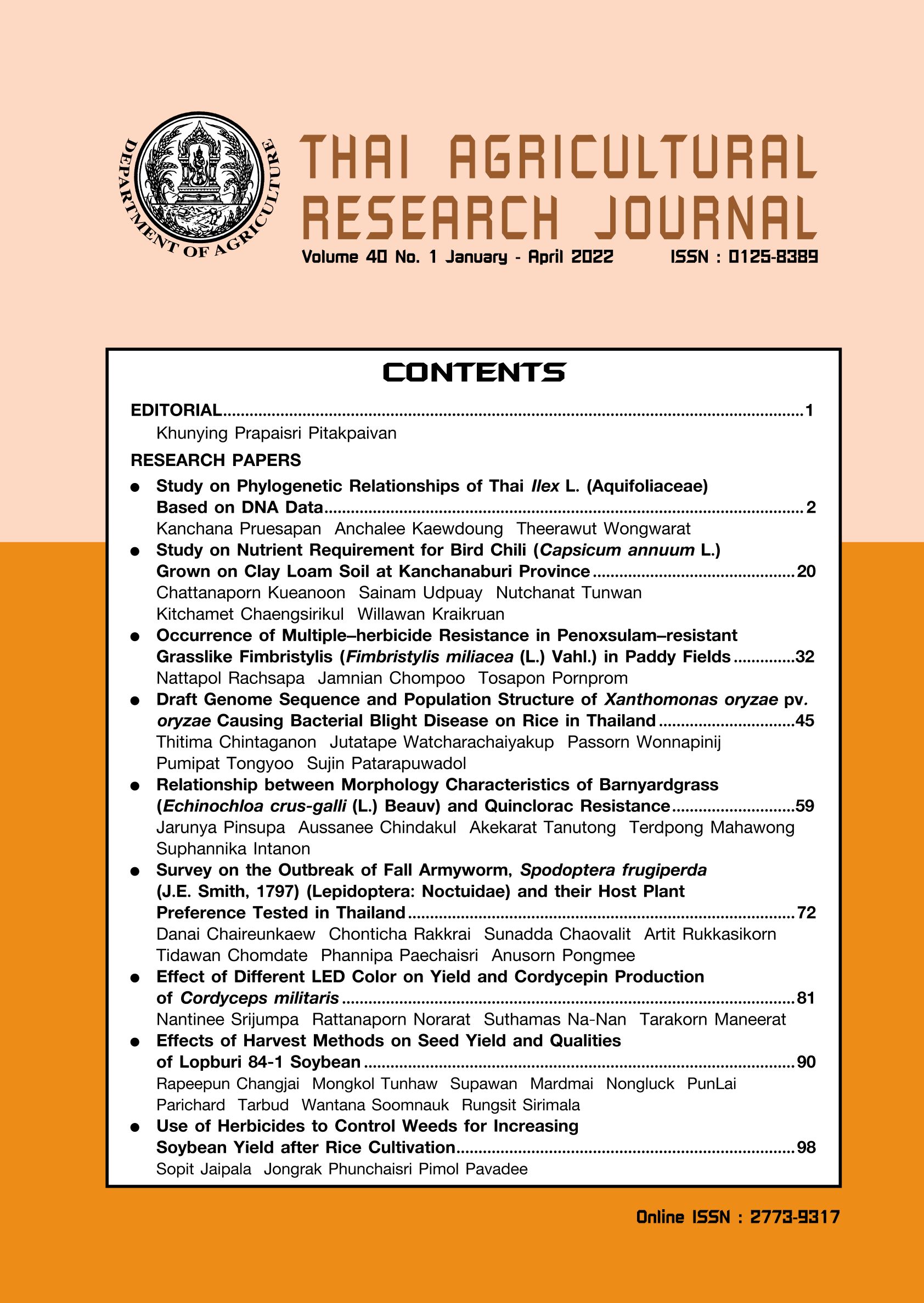Study on Phylogenetic Relationships of Thai Ilex L. (Aquifoliaceae) Based on DNA Data
DOI:
https://doi.org/10.14456/thaidoa-agres.2022.1Keywords:
Aquifoliaceae,, DNA barcode, Thai Ilex, morphological classification, phylogenetic relationshipsAbstract
Species boundaries among Ilex L. (Aquifoliaceae) are often not clear-cut due to the morphological overlap of related species. Genetic differentiation is thus needed to clarify their relationship. In the present study, we aimedto investigate the phylogenetic relationships of Thai Ilex species using DNA barcode technique. The DNA barcodes of matK, rpl32-trnL, trnL-trnF and ITS were examined and analyzed using Maximum Parsimony method. A total of 54 DNA sequence data obtained from this study representing 14 species of Thai Ilex. The phylogenetic trees resulted in five congruent main clades with morphological classification. Subgenus Aquifolium Section comprised I. odorata and I. pubifructa whereas the sectional placement for I. depressifructu was still unclear. Subgenus Byronia Section Byronia comprised I. cymosa, I. wallichii, Ilex sp. (1) andIlex sp. (2); Section Lioprinus comprised I. phanganensis and I. umbellulata; Section Paltoria comprised only I. triflora. Subgenus Prinos Section Micrococca comprised only I. micrococca. The results confirmed species identification based on morphology. The placements in the phylogenetic trees supported grouping classification for I. depressifructu, I. phanganensis and I. pubifructa which were recently described as new species for Thailand and could be used as guideline for identifying the two unknown species. More representative species of Ilex and variable DNA barcodes should be added to resolve the indefinable information from the present study and to complete research on diversity of Aquifoliaceae in Thailand.
References
Chen, S.K. and Y.X. Feng. 1999. Aquifoliaceae. pp.105–110. In: Chen, S.-K. (ed.), Fl.Reipubl. Popularis Sin., vol. 45. Science Press, Beijing.
Craib, W.G. 1931. Ilicaceae. pp. 277 – 278. In: Florae Siamensis Enumeratio: a list of the plants known from Siam, with records of their occurrence, vol. 1. Siam Society, Bangkok.
Drbkov, L.Z. 2014. DNA extraction from herbarium specimens. pp. 69 – 84. In: P. Besse (ed.), Molecular Plant Taxonomy: Methods and Protocols, vol. 1115.Humana Press,NewJersey.
Felsenstein, J. 1985. Confidence limits on phylogenies: An approach using the bootstrap. Evolution. 39(4): 783 – 791.
Galle, F.C. 1997. Hollies: the genus Ilex. Timber Press, Portland. 573 p.
Gorzalczany, S., R. Filip, M.D.R. Alonso, J. Mio, G.E.Ferraroand C. Acevedo.2001. Choleretic effect and intestinal propulsion of ‘mate’ (Ilex paraguariensis) and its substitutes or adulterants. J. Ethnopharmacol. 75: 291 – 294.
Hall, T.A. 1999. BioEdit: a user-friendly biological sequence alignment editor and analysis program for Windows 95/98/NT. Nucl. Acids. Symp. Ser. 41: 95 – 98.
Hao, D., X. Gu, P. Xiao, Z.Liang,L. Xuand Y. Peng. 2013. Research progress in the phytochemistry and biology of Ilex pharmaceutical resources. Acta Pharm. Sin. B. 3(1): 8 – 19.
Hong, D.Y. 2015. A taxonomical revision of Ilex (Aquifoliaceae) in the Pan-Himalaya and unraveling its distribution patterns. Phytotaxa. 230(2): 151 – 171.
Kumar, S., G. Stecher and K. Tamura. 2016. MEGA7: Molecular evolutionary genetics analysis version 7.0 for bigger datasets. Mol. Biol. Evol. 33(7): 1870 – 1874.
Loizeau, P.A., V. Savolainen, S. Andrews, G. Barriera and R. Spichiger. 2016. Aquifoliaceae. pp. 31 – 36. In: J. Kadereit and V. Bittrich (eds.), Flowering Plants. Eudicots. The Families and Genera of Vascular Plants 14. Springer, Cham.
Manen, J.F., G. Barriera, P.A. Loizeau and Y. Naciri. 2010. The history of extant Ilex species (Aquifoliaceae): evidence of hybridization within a Miocene radiation. Mol. Phylogenet. Evol. 57(3): 961 – 977.
Nei, M. and S. Kumar. 2000. Molecular evolution and phylogenetics. Oxford University Press, New York. 333 p.
Pruesapan, K. and P.C. van Welzen. 2021. Two new species of Ilex (Aquifoliaceae) from Thailand.Thai For. Bull. (Bot.) 49(1):66–72.
Pruesapan, K., S. Andrews and D.A. Simpson. 2014. An outline of Aquifoliaceae for the Flora of Thailand.Thai For. Bull. (Bot.) 42:125.
Pruesapan, K., S. Andrews and D.A. Simpson. 2017. Ilex pubifructa (Aquifoliaceae), a new species from northern Thailand. Kew Bull. 72(21): 1 – 4.
Setoguchi, H. and I. Watanabe. 2000. International gene flow between insular endemics of Ilex (Aquifoliaceae) on the Bonin Islands and the Ryukyu Islands. Am. J. Bot. 87(6):793–810.
Shaw, J., E.B. Lickey, E.E. Schilling and R.L. Small. 2007. Comparison of whole chloroplast genome sequences to choose noncoding regions for phylogenetic studies in angiosperms: the tortoise and the hare III. Am. J. Bot. 94(3): 275 – 288.
Shi,L., N.Li, S. Wang, Y. Zhou, W. Huang, Y. Yang, Y. Ma and R. Zhou. 2016. Molecular Evidence for the Hybrid Origin of Ilex dabieshanensis (Aquifoliaceae). PLoS One. 11(1): e0147825.
Son, S.W., J.H. Kim, K.J. Kim and S.J. Park. 2009. Molecular evidence for the hybridity of llex x wandoensis and the phylogenetic study of Korean llex based on ITS sequence data. Genes and Genomics. 31(1): 53 – 63.
Sosef, M.S.M, L.T. Hong and S. Prawirohatmodjo. 1998. Timber trees: Lesser-known timbers. Plant Resources of South-East Asia No. 5(3). Backhuys Publishers, Leiden. 859 p.
Taberlet, P., L. Gielly, G. Pautou and J. Bouvet. 1991. Universal primers for amplification of three non-coding regions of chloroplast DNA. Plant Mol. Biol. 17: 1105 – 1109.
Thomson, J.D., D.G. Higgins and T.J. Gibson.1994. CLUSTAL W: improving the sentivity of progressive multiple sequence alignment through sequence weighting, position specific gap panalties and weight metrix choice. Nucleic Acids Res. 22: 4673 – 4680.
White, T.J., T. Bruns, S. Lee and J. Taylor. 1990. Amplification and direct sequencing of fungal ribosomal RNA genes for phylogenetics. pp. 315 – 322. In: M.A. Innis, D.H. Gelfand, J.J. Sninsky, and T.J. White (eds.), PCR Protocols: A Guide to Methods and Applications. Academic Press, Inc., New York.
Yang, Y., L. Chen and H. Peng. 2018. Clarification of the taxonomic confusion between Ilex formosana and I. tetramera (Aquifoliaceae), with the description of a new species I. shukunii. Phytotaxa. 382(2): 182 – 192
Downloads
Published
How to Cite
Issue
Section
License
Copyright (c) 2022 Thai Agricultural Research Journal

This work is licensed under a Creative Commons Attribution-NonCommercial-NoDerivatives 4.0 International License.
Thai Agricultural Research Journal



